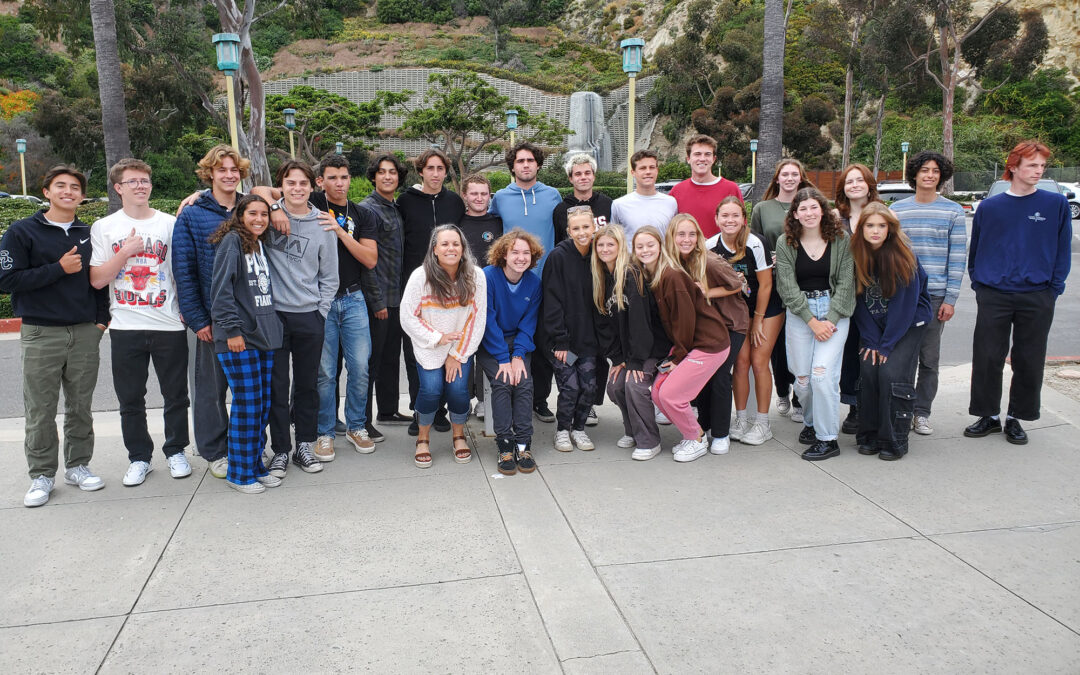Contacts:
Peter James MacCracken, APR | pjm@strategic-communications.com | (619) 275-4110
Celina Maggi | cmaggi@hswri.org | (619) 909-3449
San Clemente High Students Celebrate Completion of Sea Bass Project
By C. Jayden Smith
After first being tasked with raising 42 young white sea bass in mid-April, students from San Clemente High School celebrated the project’s conclusion by releasing the fish into the ocean on Monday afternoon, May 22.
Nancy Caruso, a marine biologist and founder of environmental stewardship organization Get Inspired, first brought the small fish to teacher Michelle Breslin’s classroom for one purpose: to grow the group of fish to weigh as much as possible before putting them into the ocean.
The students of Breslin’s five International Baccalaureate Marine Science classes accomplished just that, as the fish, which each weighed 0.8 grams on average when delivered on April 11, swelled up to weigh about 9 grams each by the time students gathered at Baby Beach in Dana Point for the release.
On Monday, Caruso told the students that they had completed a project that stood in stark contrast to the norm in the United States, where anyone could pay a nominal fee to obtain a fishing license and continuously take from bodies of water without any recompense.
“There is no one who is putting fish back in the ocean for restoration,” Caruso said in an interview with San Clemente Times on Wednesday, May 24. “There’s no pathway for anyone to put things back in the ocean for restoration. There’s no license, there is no permit you can get … I do it for a living, so I know.”
San Clemente High School became the 12th school to work with Get Inspired and the Hubbs SeaWorld Research Institute (HSWRI) on raising white sea bass, as part of the organization’s efforts to restore once-thriving species in Orange County’s kelp forest ecosystem.
The students conducted countless tests of their water tank’s pH levels, salinity, temperature and other factors and fed the fish to make sure they were experiencing the best conditions possible for growth.
This project saw the smallest group of fish in terms of relative size at the beginning, which forced Breslin and her classes to adjust as the program progressed.
“We did have some loss, and I was like, ‘Gosh, why are these fish dying?’ ” Breslin said, adding: “The kids and I were observing (that) some were getting pretty big and some were staying kind of small, so we were watching the feeding process and realizing that the little ones just weren’t getting the food.”
Their solution was to grind up the food and distribute in different sizes, and along with limiting the amount of light that came into the tank and other chemical experiments, they were able to halt the number of casualties at eight.
Caruso said there wasn’t a target weight for the fish, just as big as possible.
“We even had some alternative plans, like if they didn’t get big enough, then we could put them over at Orange Coast College because they have a huge aquarium and (we could) grow them a little bit larger in the summer,” said Caruso. “That didn’t have to happen, thankfully.”
Breslin praised her students for showing a sense of responsibility and urgency in monitoring and changing tank conditions when necessary. The students also displayed genuine interest in taking initiative for their groups and assigning different roles, with some even taking time at lunch to tend to the fish.
She added that as it relates to conservation efforts, the students learned about numerous ways in which human fishing practices, such as using nets, negatively impact the ocean.
“I think they’ll walk away feeling proud and understanding that we play a pivotal role in the health of our oceans (and) especially our coastal ecosystem,” she said.
Close to 30 students were on hand for Monday’s release, as each person had the chance to fill a gallon-sized container with ocean water, go to the coolers holding the fish and walk the 25 yards back to the water to free them in the ocean.
Some were less eager to leave the container than others, Breslin recalled, which required coaxing and a few pushes, but the event was enjoyable.
“It was fun to see all the behaviors and to see everyone’s excitement to see (the fish) being set free; (it) made all the stress of the learning curve really worth it,” she said.
Caruso said she will bring more sea bass to SCHS during the 2023-2024 school year and that she is excited to include the students in more research projects centered around growth techniques.
Link to Publication
###

